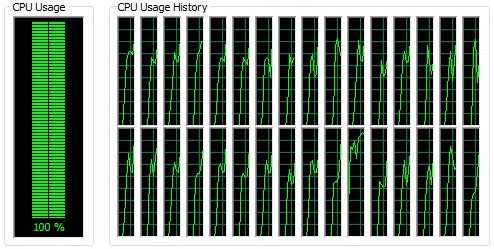Intel Xeon E5-2600: Doing Damage With Two Eight-Core CPUs
Intel's vaunted Sandy Bridge architecture has finally made its way to the company's dual- and quad-socket-capable Xeon processors. We got our hands on a pair of eight-core Xeon E5-2687W CPUs to compare against the older Xeon 5600- and 5500-series chips.
Xeon E5: Respectable Performance Boost, Bigger Efficiency Gain
The Sandy Bridge architecture was a really big deal on the desktop. More than a year after its introduction, Core i5-2500K is still the processor I recommend to friends who ask for buying advice. And although it took Intel a long time to incorporate Sandy Bridge into its server and workstation portfolio, the resulting effort is complex, and yet scalable in a way that only the Xeon E7s can rival.
There are 37 different Xeon E5s. We only got our hands on one. But the Xeon E5-2687W is the fastest model, and we were able to benchmark it against three other flagships in their respective families: Xeon W5580, Xeon X5680, and Core i7-3960X. Obviously, the performance you get from any dual-processor platform is wholly dependent on the tasks you throw at it. Our test suite is predominantly workstation-oriented. But even with lightly-threaded benchmarks folded in, the Xeon E5s were about 21% faster, on average, than the Xeon 5600s. After factoring out the tests you typically wouldn’t see on a workstation, the advantage grew just a hair to almost 23%.
But while comparing the Xeon E5s to the Xeon 5600s was interesting, I was more impressed by the efficiency calculation than any other piece of data. The Xeon E5-2687W is etched using the same 32 nm node. It’s way larger. And its TDP is 20 W higher per processor. Indeed, you can clearly see that, under full load, two Xeon E5-2687Ws draw more power from the wall than the Xeon X5680s. But the speed-up attributable to Intel’s Sandy Bridge architecture and two additional cores per socket outweighs the power spike, yielding better efficiency.
Consider also that the E5’s strengths are more accessible across a wider range of segments. There are now eight-core processors available for entry-level dual-socket servers in the Xeon E5-2400 family. A single-socket Xeon E5-1600 workstation line-up offers similar functionality as the Core i7-3000 series, adding RAS functionality important to some folks. The Xeon E5-2600s cover a broad range of 2S servers and workstations. And a line of Xeon E5-4600 processors introduces the idea of more commoditized quad-socket configurations that maximize performance/watt in HPC environments.
Obviously, if you’re a professional working in a data center, the prospect of improving efficiency is a head-turner. Similar, engineers and artists looking at next-gen workstations have to appreciate a platform that averages 20% better performance. But even if you’re a hardware enthusiast with no reason to use any of this gear, it’s still pretty cool to pop open Windows’ Task Manager and watch 32 threads go to town rendering a scene that could end up in the next game you enjoy.
Get Tom's Hardware's best news and in-depth reviews, straight to your inbox.
Current page: Xeon E5: Respectable Performance Boost, Bigger Efficiency Gain
Prev Page Power Consumption And Efficiency-
CaedenV My brain cannot comprehend what CS5 would look like with this combined with a 1TB R4 drive, and the GTX680 version of the Quatro would look like... and I am sure my wallet cannot!Reply
Great article! I was not expecting my mind to be blown away today, and it was :) -
dalethepcman No gaming benchmarks? I know this is a high workstation / mid server build, but you know some of the boutiques will make a gaming rig out of any platform. Just out of curiosity, I would have liked to see 2x7970 or 2x580 and a few gaming benchmarks thrown in. :)Reply -
willard dalethepcmanNo gaming benchmarks? I know this is a high workstation / mid server build, but you know some of the boutiques will make a gaming rig out of any platform. Just out of curiosity, I would have liked to see 2x7970 or 2x580 and a few gaming benchmarks thrown in.I'd be really surprised to see these in gaming machines, even in the high end boutiques. That's a $2k processor they reviewed, and basically all it offers over the $1k SB-E chip (for gamers) is an extra pair of cores, which games can't make use of.Reply -
reclusiveorc I wonder how fast TempEncode would chew thru transcoding avi/wmv files to mp3/mp4Reply -
willard esreverwhy aren't AMD cpus tested too? I wouldn't mind seeing how 2x interlagos stacks up.Anandtech benched those next to the new Xeons. Went about as well as Bulldozer vs. Sandy Bridge.Reply
http://www.anandtech.com/show/5553/the-xeon-e52600-dual-sandybridge-for-servers/6 -
cangelini esreverwhy aren't AMD cpus tested too? I wouldn't mind seeing how 2x interlagos stacks up.Mentioned on the test page--I've invited them to send hardware and they haven't moved on it yet.Reply -
willard cangeliniMentioned on the test page--I've invited them to send hardware and they haven't moved on it yet.I would guess that's because Interlagos is garbage compared to the new Xeons and they know it. I don't think they're terribly eager for the front page of Tom's Hardware to show the low end Xeon's beating the best Interlagos has to offer.Reply -
Onus What, or who, was the target? Are there military applications for this weapon?Reply
Sorry, vote me down all you like, but the title was just silly.

